Caryn’s Thoughts

 As events from the past get further and further from the present, it’s easy to forget all about them, and for the younger generations…well, they never knew about them, unless they learned about them in history class. In my opinion and the opinion of many conservatives, one of the greatest presidents of all time, was President Ronald Reagan. As a young man, I’m sure no one would have expected that he would even pe president. He was, after all, an actor, and not a politician. Nevertheless, he stepped out of that role, and became first the governor of California, and later the President of the United States, and it was at a pivotable time in history that he was the president.
As events from the past get further and further from the present, it’s easy to forget all about them, and for the younger generations…well, they never knew about them, unless they learned about them in history class. In my opinion and the opinion of many conservatives, one of the greatest presidents of all time, was President Ronald Reagan. As a young man, I’m sure no one would have expected that he would even pe president. He was, after all, an actor, and not a politician. Nevertheless, he stepped out of that role, and became first the governor of California, and later the President of the United States, and it was at a pivotable time in history that he was the president.
Our nation was in the middle of the Cold War, which had really fired up in 1945, at the end of World War II, and continued on until 1991. During that time, we experienced the Iran Hostage Crisis on November 4, 1979, that lasted until January 20, 1981, spanning a total of 444 days. The hostage rescue finally came after President Reagan ordered it, when he became president. He was not afraid to act. He saw something that was unacceptable, and he remedied it…just hours after his inaugural speech. It shouldn’t have taken 444 days to 
 free these hostages, but until President Reagan stepped in, there was just one attempt, and it failed. The 52 hostages felt forgotten, until President Reagan and the men he sent in, rescued them.
free these hostages, but until President Reagan stepped in, there was just one attempt, and it failed. The 52 hostages felt forgotten, until President Reagan and the men he sent in, rescued them.
During President Reagan’s two terms in office, he worked tirelessly to change many things for the better. He hated tyranny, no matter what country it invaded. He looked at the Berlin Wall for what it was tyranny. Those people had been taken hostage and separated from their friends and family for long enough. In one of his most well-known speeches, President Reagan called for the tyranny to end, when on June 12, 1987, he challenged Soviet Leader Mikhail Gorbachev to “tear down this wall,” which had long been a symbol of the repressive Communist era in a divided Germany. Of course, the wall didn’t come down immediately, and in fact, it wasn’t until November 9, 1989, that it actually came down.
President Reagan was at the helm when the Space Shuttle Challenger exploded just 73 seconds after liftoff. It was a tragic event in the space program, and the people of this nation need to be consoled. President Reagan was just the man to give this nation the support it needed. His speech that day was supposed to have been the 1986 State of the Union speech, but President Reagan knew this was more important, so he delayed the State of the Union speech, and instead gave a speech to console us saying, “Ladies and gentlemen, I’d planned to 
 speak to you tonight to report on the state of the Union, but the events of earlier today have led me to change those plans. Today is a day for mourning and remembering.” He concluded his speech saying, “We will never forget them, nor the last time we saw them, this morning, as they prepared for their journey and waved goodbye and ‘slipped the surly bonds of earth’ to ‘touch the face of God.'” President Reagan was truly a great president. President Reagan served two terms as president, from 1981 to 1989. He died on June 5, 2004, at age 93.
speak to you tonight to report on the state of the Union, but the events of earlier today have led me to change those plans. Today is a day for mourning and remembering.” He concluded his speech saying, “We will never forget them, nor the last time we saw them, this morning, as they prepared for their journey and waved goodbye and ‘slipped the surly bonds of earth’ to ‘touch the face of God.'” President Reagan was truly a great president. President Reagan served two terms as president, from 1981 to 1989. He died on June 5, 2004, at age 93.

 Car racing has been around since cars have been around, and for the most part, professional car racing has been a fairly safe event, but that isn’t always the case. One of the big races is the Le Mans 24 race, which was organized by France’s Automobile Club de L’Ouest, was first held in May 1923. Since that time, the race has been held nearly every June. The race is an unusual kind of race in that it begins at 4 pm on a Saturday afternoon. It lasts for the next 24 hours over a 13-kilometer course running through the country roads near Le Mans. The winner is the racer who covers the greatest distance in the 24-hour period. Some of the rules have changed for safety purposes. Originally each car could only have a single driver. Then the rule was changed in 1970, allowing each car to have two drivers. These days, three are required. Eddie Hall managed to complete the entire race alone in the 1950 edition of Le Mans 24 and is the only person in history to do so. Several other drivers have tried in the early years of the event, but then it was outlawed.
Car racing has been around since cars have been around, and for the most part, professional car racing has been a fairly safe event, but that isn’t always the case. One of the big races is the Le Mans 24 race, which was organized by France’s Automobile Club de L’Ouest, was first held in May 1923. Since that time, the race has been held nearly every June. The race is an unusual kind of race in that it begins at 4 pm on a Saturday afternoon. It lasts for the next 24 hours over a 13-kilometer course running through the country roads near Le Mans. The winner is the racer who covers the greatest distance in the 24-hour period. Some of the rules have changed for safety purposes. Originally each car could only have a single driver. Then the rule was changed in 1970, allowing each car to have two drivers. These days, three are required. Eddie Hall managed to complete the entire race alone in the 1950 edition of Le Mans 24 and is the only person in history to do so. Several other drivers have tried in the early years of the event, but then it was outlawed.
In 1952, during the one driver years, Pierre Levegh, a Frenchman driving alone, might have won the race, but he made one single mistake in the last hour. Levegh was invited to join the Mercedes-Benz team three years later. Their 300SLR was to be outfitted with a new innovation, an air brake that would enhance cornering. It must have been an exciting thought, but Levegh complained that the course was too narrow near the pit-stop area and the grandstand. He was worried about the tight turn. His observation was proven to be almost prophetic. In that very turn, as Levegh was racing for the lead near the tight pit-stop area, he swerved to avoid fellow racer Mike Hawthorn’s Jaguar moving toward the pits. Levegh’s car, which was traveling at about 150 miles per hour, hit Lance Macklin’s Austin-Healey and shot upward. The car crashed into the grandstand and car parts sprayed straight into the crowd. In the fiery crash, Levegh and more than 80 spectators, who were packed into the grandstand, lost their lives. The race went on despite the horrific accident, and in the end, it was thought that Hawthorn won. The remaining spectators had to stay where they were, because if they had left the area, they would have blocked the ambulances called to pick up the dead and injured.

 Grand Prix races in Germany and Switzerland, which had been scheduled for later that year were cancelled. Spain and Mexico temporarily banned motor racing following the 1955 Le Mans tragedy. Of course, the bans didn’t last very long…just long enough for people to realize that safety had to be a priority, and to put safety measures in place to protect the crowds. That doesn’t mean that tragedy can’t happen at a race, but it is usually on a much smaller scale.
Grand Prix races in Germany and Switzerland, which had been scheduled for later that year were cancelled. Spain and Mexico temporarily banned motor racing following the 1955 Le Mans tragedy. Of course, the bans didn’t last very long…just long enough for people to realize that safety had to be a priority, and to put safety measures in place to protect the crowds. That doesn’t mean that tragedy can’t happen at a race, but it is usually on a much smaller scale.
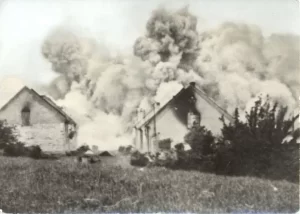
 Reinhard Tristan Eugen Heydrich was a high-ranking German SS and police official during the Nazi era and a principal architect of the Holocaust. Because of the horrific things the man known as “Heydrich the Hangman” had done, the Czechoslovakian government-in-exile had decided they needed to get rid of him. The assassination didn’t go quite as planned when the assassin’s gun jammed, but a bomb thrown succeeded, albeit after a few days, caused Heydrich to contract sepsis, which ultimately lead to his death on June 4, 1942.
Reinhard Tristan Eugen Heydrich was a high-ranking German SS and police official during the Nazi era and a principal architect of the Holocaust. Because of the horrific things the man known as “Heydrich the Hangman” had done, the Czechoslovakian government-in-exile had decided they needed to get rid of him. The assassination didn’t go quite as planned when the assassin’s gun jammed, but a bomb thrown succeeded, albeit after a few days, caused Heydrich to contract sepsis, which ultimately lead to his death on June 4, 1942.
There was no evidence that the people of the village of Lidice, Czechoslovakia had anything to do with his death, but that didn’t matter to Hitler. On June 10, 1942, Hitler sent his troops to obliterate the village of Lidice, Czechoslovakia. They had apparently been chosen as the example to all others that killing Hitler’s men was not going to be tolerated. The troops went in and killed all the adult males and deported most of the surviving women and children to concentration camps. The retaliation against these innocent people for something they had no control over, was brutal!! The massacre was carried out just a day after the Nazis rounded up the residents of Lidice, which is located near Prague. During the raid, SS troops herded all the town’s male residents aged 16 years and older…a total of more than 170…to a local farm and gunned them all down. The Germans then shot seven women who tried to run, and deported the remaining women to Ravensbrück concentration camp, which was a women’s slave labor camp. At Ravensbrück about 50 prisoners died, and three were recorded as “disappeared.” Of some 105 children in the village, one was reported shot while trying to run away, and approximately 80 were reported murdered in Chelmno Killing Center, and a handful were reported murdered in German Lebensborn orphanages. A few of the orphans, who were deemed “racially pure” by Nazi standards, were dispersed throughout German territory to be renamed and raised as Germans. After the massacre, SS agents burned Lidice, blew up what was left with dynamite, and leveled the debris. The destruction was to be complete at all costs.
On child, Marie Supikova, a Lidice survivor, was just 9 during the massacre. She tells of the horrible train ride to Poland after her father was executed and her mother was sent to Ravensbrück. “We cried and cried because we were very scared, upset and confused,” Supikova told BBC in a 2012 interview. Because she looked “racially 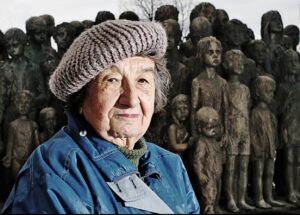
 pure” she was spared. She was sent to a German family living in Poland and had her name changed to Ingeborg Schiller. “We all had blonde hair and blue eyes. We looked like the type that they could German-ize easily and raise as a good German girl or boy,” she said. Today, the Lidice Memorial honors the memory of the victims killed in the totally senseless annihilation of the village of Lidice.
pure” she was spared. She was sent to a German family living in Poland and had her name changed to Ingeborg Schiller. “We all had blonde hair and blue eyes. We looked like the type that they could German-ize easily and raise as a good German girl or boy,” she said. Today, the Lidice Memorial honors the memory of the victims killed in the totally senseless annihilation of the village of Lidice.

 My niece, Kayla Stevens is a busy mom of two active daughters, Elliott and Maya. She and Her husband, Garrett have realized that since the birth of their second daughter, their house is too small. Garrett tells me that they are “spilling out at the seams!” So, they have been busy updating everything and fixing things up. Kayla is the visionary in the renovating process. She picks out the paint colors and makes sure things match well and complement each other. They painted the outside of the house last summer and put a rock driveway in making the outside more or less finished. Then, over this past winter, they repainted the living room, hallway, and updated the entire kitchen including cabinets, countertops, and walls. They still have a few more rooms in the basement to finish painting and then they can finish getting the majority of their stuff moved to the storage shed to prepare for the sale of the home.
My niece, Kayla Stevens is a busy mom of two active daughters, Elliott and Maya. She and Her husband, Garrett have realized that since the birth of their second daughter, their house is too small. Garrett tells me that they are “spilling out at the seams!” So, they have been busy updating everything and fixing things up. Kayla is the visionary in the renovating process. She picks out the paint colors and makes sure things match well and complement each other. They painted the outside of the house last summer and put a rock driveway in making the outside more or less finished. Then, over this past winter, they repainted the living room, hallway, and updated the entire kitchen including cabinets, countertops, and walls. They still have a few more rooms in the basement to finish painting and then they can finish getting the majority of their stuff moved to the storage shed to prepare for the sale of the home.
Garrett was telling me the about the distinct differences between him and Kayla. He says, “Kayla is very much a mom. And maybe I think that because I am a dad and it’s very different. She makes all her decisions around the kids. Most of the things she wants to do are things like going to the park or the pool or Playland at the YMCA. If it’s not that, she likes shopping for the kids. She is always finding deals after each season is over. She is a bargain hunter for sure and she is good at it.” 
When it comes to travel, Kayla is the travel agent in the family too. She makes sure that their trips will bring the most pleasure each person in the family. They took a trip to WaTiki in Rapid City over spring break with her cousin and her kids. Everyone had a blast, and the kids enjoyed every minute. Kayla is used to travel and planning for travel. Her job with the Veteran’s Administration as an Outreach Coordinator, and her job requires that she travel a lot during the summer. Part of her duties is to work with other groups and organizations. She has traveled to Washington DC several times, and while there she meets with our representatives, or their staff at least, depending on how busy they are. While there, she advocates for legislation to help with mental health and suicide prevention. We all know how important these areas are, because of the ramifications of having untreated individuals with mental health issues and those who are a suicide risk. These people need to be helped, not ignored. The advocates usually get one day with the representatives, and the rest of the trip will consist of conferences to educate them on the latest research and statistics. There is normally very little time for sight-seeing, but the last trip she made, she was able to go and see the sights between events and they enjoyed that. Then, she got stuck there for a few extra days as all the airports were short staffed and having issues. I’m not sure how well she enjoyed that, because she really wanted to get home to her family, but there was no other option. Kayla also makes trips to Jackson Hole, Powell, Pinedale, Gillette, Casper, Dubois, Lander, Cheyenne, and a few others. Over the past year she also made a trip to Arizona and Salt Lake City. In the past, she has also gone to Orlando, as well. She will be going to Oregon in the near future. In 
 addition, Kayla is working in leadership for the city of Sheridan, as well. She is a very busy girl, but her family is, and always will be her family. She has been blessed to have parents and in-laws who can step in to help with the girls when she has to be away, and Garrett has to work.
addition, Kayla is working in leadership for the city of Sheridan, as well. She is a very busy girl, but her family is, and always will be her family. She has been blessed to have parents and in-laws who can step in to help with the girls when she has to be away, and Garrett has to work.
While her summers are very busy with work and travel, she still makes sure that her family gets to do things too. She and Garrett bought a new camper, and they will be going up to the mountains, the Tongue River Reservoir in Montana, and to Pathfinder Reservoir with his family for the traditional Steven’s Family Summer Camp Out. Kayla leads a busy life, but it makes her happy, and that’s what really matters. Today is Kayla’s birthday. Happy birthday Kayla!! Have a great day!! We love you!!

 Fifty years ago today, on June 8, 1974, my friends and now sister-in-law and brother-in-law, Debbie and LJ Cook said “I do.” It was a beautiful ceremony. The bride’s mother, Joann Schulenberg was an amazing seamstress, and she made the wedding gown and the bride’s maid’s (me) dresses. Debbie and LJ have had a long and happy marriage, filled with mostly good things. They had three daughters, Machelle Moore, Nancy Cook (who went to Heaven shortly after her birth), and Susan Griffith. They lived in Casper, Wyoming for a short time after their marriage, then moved too Thermopolis, Wyoming for a short time, before moving to Powell, Wyoming, where they would make their permanent home and raise their girls. The girls have married now, and sons-in-law, Steve Moore and Josh Griffith have joined the family. In addition, grandchildren Weston Moore, Jala Satterwhite, Easton Moore, and Kaytlyn Griffith have also blessed the family.
Fifty years ago today, on June 8, 1974, my friends and now sister-in-law and brother-in-law, Debbie and LJ Cook said “I do.” It was a beautiful ceremony. The bride’s mother, Joann Schulenberg was an amazing seamstress, and she made the wedding gown and the bride’s maid’s (me) dresses. Debbie and LJ have had a long and happy marriage, filled with mostly good things. They had three daughters, Machelle Moore, Nancy Cook (who went to Heaven shortly after her birth), and Susan Griffith. They lived in Casper, Wyoming for a short time after their marriage, then moved too Thermopolis, Wyoming for a short time, before moving to Powell, Wyoming, where they would make their permanent home and raise their girls. The girls have married now, and sons-in-law, Steve Moore and Josh Griffith have joined the family. In addition, grandchildren Weston Moore, Jala Satterwhite, Easton Moore, and Kaytlyn Griffith have also blessed the family.
Their daughter, Susan was telling me about her favorite memories from her childhood. She is reminded of their gardens, both floral and vegetable. Debbie and LJ plant a garden every year, and they have since the girls were little. They truly have green thumbs too, because Susan says, “consistently, they always have such beautiful 
 flowers in their yard, and beautiful veggies growing in the garden.” She says, “The taste of home-grown tomatoes will always remind me of growing up, eating them like apples.” Unfortunately, their garden was damaged this year by the cold weather, so they had to go to the greenhouse twice and plant twice. Hopefully they end up getting some good ones with the second planting. This year, Debbie and LJ added raised beds to their gardening toolbox. They’re so much easier to take care of!
flowers in their yard, and beautiful veggies growing in the garden.” She says, “The taste of home-grown tomatoes will always remind me of growing up, eating them like apples.” Unfortunately, their garden was damaged this year by the cold weather, so they had to go to the greenhouse twice and plant twice. Hopefully they end up getting some good ones with the second planting. This year, Debbie and LJ added raised beds to their gardening toolbox. They’re so much easier to take care of!
Susan loves that her parents still live in the house where she grew up. People don’t often stay for many years in the home where they raised their kids, but it is very cool when they do. Susan also loves that her daughters and nephews know that house as well as she does, and for them to see where she and her sister grew up. The kids also have the blessing of being able to glean the wisdom their grandparents have to share, about everything from gardening to school to life. Growing up near your grandparents is a huge blessing, even if you move away after your grown. Those young years spent around grandparents will go with you wherever you go.
Since LJ retired, he and Debbie spend most of their time together. If it’s possible, they have grown closer, and their love has grown deeper. They also have their sweet little dogs to keep them on their toes and the dogs also 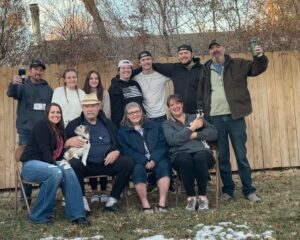
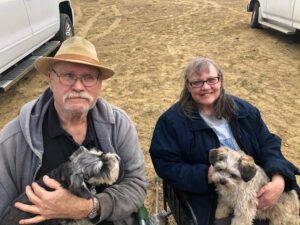 give everyone some good entertainment. The past fifty years have really flown by. In many ways, it seems like just yesterday that they were married, and yet, we know it isn’t. Many marriages these days don’t stand the test of time, but the love Debbie and LJ have for each other has done just that, and I have no doubt their love will grow deeper and deeper for the rest of their lives. Happy Golden Anniversary Debbie and LJ!! Congratulations on 50 years together!! Have a wonderful day!! We love you!!
give everyone some good entertainment. The past fifty years have really flown by. In many ways, it seems like just yesterday that they were married, and yet, we know it isn’t. Many marriages these days don’t stand the test of time, but the love Debbie and LJ have for each other has done just that, and I have no doubt their love will grow deeper and deeper for the rest of their lives. Happy Golden Anniversary Debbie and LJ!! Congratulations on 50 years together!! Have a wonderful day!! We love you!!

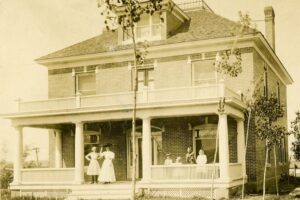 As the westward movement progressed different areas began to emerge as important places along the trail to places like Utah, Oregon, and California. One of those important places, as it turns out, was Casper, in what would one day be the state of Wyoming. On the journey west, water was essential, and so the wagon trains often followed and even crossed the rivers as the terrain necessitated. Because the future city of Casper was located on the banks of the North Platte River, it was a logical location for a town, that later became a city. In order to locate a cut through the Rocky Mountains, the Platte River proved to be the key.
As the westward movement progressed different areas began to emerge as important places along the trail to places like Utah, Oregon, and California. One of those important places, as it turns out, was Casper, in what would one day be the state of Wyoming. On the journey west, water was essential, and so the wagon trains often followed and even crossed the rivers as the terrain necessitated. Because the future city of Casper was located on the banks of the North Platte River, it was a logical location for a town, that later became a city. In order to locate a cut through the Rocky Mountains, the Platte River proved to be the key.
As the trail of emigrants made their way across the continent, Casper was formed, and a man named John Baptist Richard could see that the river could be a necessity as a water source, but also a hinderance in that crossing it wasn’t always easy. A ferry had been established in 1847 to get emigrants across the Platte River on their way west on the Oregon-California Trail, but later Richard two bridges were erected in the 1850’s to improve the passage of settlers on their westward march. The first bridge was built in 1851 just east of present-day Casper, in the area of present-day Evansville. The second bridge became much more successful bridge and was built in 1859-1860. This bridge came to be known as the “Platte Bridge” and was a important mark on the Oregon-California trail. Later, with the establishment of the Platte Bridge Station in 1858, renamed Fort Caspar by the military in 1864 the fort and the bridge were major forces that contributed to the formation of Casper. Fort Caspar was abandoned in 1867, but the town of Casper remained, and was prosperous.
The military no longer needed the fort, and shortly thereafter, the bridges burned by the Indians. A short time later, white settlers began to develop the area. It turned out that the area was perfect for ranching. From the 1860’s through the 1880’s large cattle ranches were established near Casper. Ranches such as the Sun Ranch on the Sweetwater, the Goose Egg Ranch of the Seebright Brothers at Bessemer Bend, the Carey Ranch near the old Platte Bridge, and the Brooks Ranch east of modern-day Casper dotted the landscape.
It was about this time that John Merritt and C W Eads learned of this railroad expansion. It is believed that they were the first to arrive in what would eventually be known as Casper. On the afternoon of June 7, 1888, they pitched a tent at a spot near what is today known as McKinley and “A” Streets and established the town of Casper. As the city grew, this area would become known as “Old Town.” The town grew slowly and for two decades was one of a number of small villages dotting the plains serving local cattle operations. As in most frontier towns, the standard businesses were quickly established…four saloons and restaurants, three livery stables, one grocery store, and two general stores. As was also common, most buildings were frame construction. At that time, there were fewer than a thousand people living in the town. Marvin Lord Bishop Sr moved to Casper, Wyoming on September 1, 1892, after being appointed postmaster by President Grover Cleveland the 22nd President of the United States and a member of the Democratic Party. He later changed his affiliation to the Republican Party. His party affiliation resulted in his appointment to this prestigious position of postmaster in the developing community of Casper. While he was not the first postmaster, he was the first person to stay in the position for more than two years and is credited with bringing stability and permanence to the office as the fledgling community developed. The postmaster was on duty from 7:00am to 9:00pm…so much for bankers hours there. The salary ranged from $50.00 to $100.00 per month which would be between $1750 and $3500 today…not a bad wage, especially considering that little mail was handled in those early days. Trips to town were not an everyday occurrence for the ranchers, so when they came in, about every four months, their first stop was often the post office to get the mail that had accumulated since the last visit or since a neighbor had last brought it to them.
In addition to the post office, Mr Bishop also had a small store attached to the post office, that he also operated. It was called M. L. Bishop’s Cash Store for “Fine Family Groceries” and was one of the few businesses established in Casper in the 1890s. Bishop also helped to establish one of the earliest churches in Casper, the First Methodist Episcopal Church, now known as the First United Methodist Church. He was one of five men in Casper who met in the early spring of 1893 to discuss the importance of establishing a religious community in the developing town of Casper and to formulate plans for the formation of this church. In 1896, the church had 22 members, out of which the Bishop family, now numbering six, held a significant presence.
Because the position of postmaster was a political patronage position, Bishop began to make plans for his future, in the event of a political climate change. In May 1894 he entered into sheep ranching, purchasing land from Edward T David, another early pioneer and foreman for the Carey Ranch. His resignation as Postmaster in August 1898 began a period of 40 years when M L Bishop became a woolgrower with holdings in the Pathfinder Dam area southwest of Casper and the owner of the sheep shearing pens located at Casper Creek. Over the years, and due to some twists of fate, like the Civil War, and the movement of wool growing from the East to the Western plains and mountains, brought much wealth to the Bishop family. With Bishop’s businesses were thriving and he decided to purchase land at 818 East Second Street for a new home in 1906. He bought two adjacent lots on East Second Street in Casper in the Capitol Hill Addition from another early pioneer, Robert White. The contractor for the Bishop Home was W T Evans, founder of Evansville, Wyoming. Mr Evans built numerous other buildings in the burgeoning town of Casper such as the Town Hall in 1890 and the Saint Mark’s Episcopal Church in 1891. In addition, he built the first one-story, four-room brick home at First and Wolcott streets for his daughter and son-in-law in the late 1890’s. This home was considered one of the largest homes in Casper until Mr. Evans built the two and one-half story Bishop home with fifteen rooms. The Bishop house, built in 1907, is believed to be his first venture into large-scale, multi-story family homes.
By 1929, the year the stock market crashed, the oil boom was coming to an end, also. The boom had been furious, powerful, and seemingly endless, and before it faded from sight, that boom had made Casper, Wyoming what it was and largely what it remains today. Always a “boom and bust” town, Casper would survive whatever came its way.
In 1938, Bishop was elected County Commissioner and his years of accumulated knowledge of sheep ranching were recorded that same year by the Wyoming Works Progress Administration (WPA). He died the following year. With his death, the strains on the economy from the great depression, and the decline in the Wyoming sheep production, the family could not maintain the ranch and shearing pens. Wyoming. Bishop’s wife, Leona, continued to live in the home until her death in 1948. In total the couple had ten children. All children resided in Wyoming and were prominent in their communities with the exception of one daughter who died in infancy. T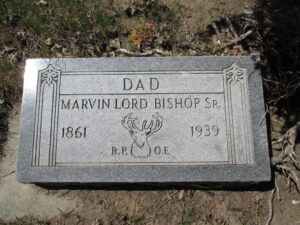
 heir youngest daughter, Lucile L Bishop, lived in the family home from the time of her birth in October 1908 until her death in 1997. Then, the M L Bishop House was placed on the National Register of Historic Places because of its association with the development of Casper and the surrounding area from a small village to a livestock center, and eventually, to an oil town. The home is still open for tours, and I plan to go in the near future.
heir youngest daughter, Lucile L Bishop, lived in the family home from the time of her birth in October 1908 until her death in 1997. Then, the M L Bishop House was placed on the National Register of Historic Places because of its association with the development of Casper and the surrounding area from a small village to a livestock center, and eventually, to an oil town. The home is still open for tours, and I plan to go in the near future.

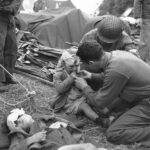 Not every soldier that stormed the beaches at Normandy, France on D-Day (June 6, 1944), carried a gun…or any other weapon. I’m not saying these men were more brave that their armed counterparts, because all of those men were targets. They all knew, going in that it was very unlikely that they would come home again. They were running onto an armed beach in broad daylight, with the plan of taking down the strongholds that existed there. The main difference between the armed soldiers and the medics was the inability to protect themselves. The medics weren’t there to fight. They were there to save. The were the only thing standing between the armed soldiers and certain death. Just the thought of that brings tears to my eyes. All the men who stormed those beaches faced almost certain death, and yet they knew they had to go. They couldn’t live with themselves if they didn’t do their best, be it killing the enemy soldiers or saving the wounded soldiers.
Not every soldier that stormed the beaches at Normandy, France on D-Day (June 6, 1944), carried a gun…or any other weapon. I’m not saying these men were more brave that their armed counterparts, because all of those men were targets. They all knew, going in that it was very unlikely that they would come home again. They were running onto an armed beach in broad daylight, with the plan of taking down the strongholds that existed there. The main difference between the armed soldiers and the medics was the inability to protect themselves. The medics weren’t there to fight. They were there to save. The were the only thing standing between the armed soldiers and certain death. Just the thought of that brings tears to my eyes. All the men who stormed those beaches faced almost certain death, and yet they knew they had to go. They couldn’t live with themselves if they didn’t do their best, be it killing the enemy soldiers or saving the wounded soldiers.
Most soldiers are trained to shoot, fight, and kill the enemy, but a combat medic is very different. He is trained to do the exact opposite. The medics had no guns. They went in to “battle” unarmed, and their mission wasn’t to attack the enemy, it was to dodge the bullets that were flying everywhere and get to the soldiers who had been wounded. Then they tried to get them off the battlefield so they could treat their wounds, and hopefully save their lives. Sometimes, they had to treat them where they were. Bullets don’t distinguish between a soldier and a medic.
There are, of course, far too many medics who have bravely gone in to try to save other soldiers at the risk of losing their own lives. While the armed soldiers fight the battles, medics pick up the pieces during and after the battle. It’s the medics who gather up the belongings of those they cannot save, so they can be returned to the families. They don’t really have much time before they must move on to the next wounded soldier, and so often they grab the dog tags, because it is the only true way to know who this soldier was. It’s the only way to let their family know that their brave soldier gave the ultimate sacrifice in battle.
My dad, Staff Sergeant Allen Spencer was a top turret gunner and flight engineer in one of the B-17s that 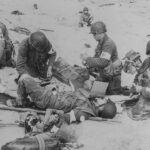
 provided cover for the men as they stormed the beaches of Normandy that fateful day. My uncle, Jim Wolfe was one of the men below, storming the beaches. I don’t know if they knew each other then, but they would later, when my Uncle Jim married my dad’s sister, Ruth. It’s very hard to think about this battle, because so many lives were lost. I don’t know how anyone made it onto that beach without getting pelted with a barrage of bullets, but I am thankful for the medics who were there to try to pick up the pieces. Today marks the 80th anniversary of D-Day. From a grateful nation, we honor all who fought in that horrific battle. Very brave men all!!
provided cover for the men as they stormed the beaches of Normandy that fateful day. My uncle, Jim Wolfe was one of the men below, storming the beaches. I don’t know if they knew each other then, but they would later, when my Uncle Jim married my dad’s sister, Ruth. It’s very hard to think about this battle, because so many lives were lost. I don’t know how anyone made it onto that beach without getting pelted with a barrage of bullets, but I am thankful for the medics who were there to try to pick up the pieces. Today marks the 80th anniversary of D-Day. From a grateful nation, we honor all who fought in that horrific battle. Very brave men all!!

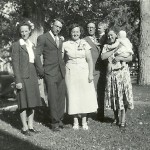 My in-laws, Walt and Joann Schulenberg knew each other their whole lives. They were from the small town of Forsyth, Montana, and their mothers, Vina Schulenberg Hein and Nettie Knox were good friends. They did things together and hung out for pleasant afternoon visits while their children slept. Walt was the older of the two by a year and a half, but they were still playmates as kids, and they even took naps together, which was something that embarrassed my rather prim and proper mother-in-law. Oh, she wasn’t a snob, but in those days, people just didn’t do that sort of thing (the sleeping together, not the napping part). Mostly it was a matter of the fact that you just didn’t talk or joke about such things, Nevertheless, we all teased them…well mostly her, because it didn’t bother my father-in-law one bit.
My in-laws, Walt and Joann Schulenberg knew each other their whole lives. They were from the small town of Forsyth, Montana, and their mothers, Vina Schulenberg Hein and Nettie Knox were good friends. They did things together and hung out for pleasant afternoon visits while their children slept. Walt was the older of the two by a year and a half, but they were still playmates as kids, and they even took naps together, which was something that embarrassed my rather prim and proper mother-in-law. Oh, she wasn’t a snob, but in those days, people just didn’t do that sort of thing (the sleeping together, not the napping part). Mostly it was a matter of the fact that you just didn’t talk or joke about such things, Nevertheless, we all teased them…well mostly her, because it didn’t bother my father-in-law one bit.
The two of them grew apart s their school years went on, and my mother-in-law told me that she really didn’t like him much then. My guess is that he was always joking around and she didn’t think it was all that funny.  Nevertheless, he persevered and soon he won her heart. They talked about what their future would hold…things like how many kids they would have and the fact that he wanted a little girl, just like her baby sister, Margee Kountz. He loved kids, and he wanted a bunch of them. And a bunch of them, they did have. They had six kids all together…Marlyce Schulenberg (who passed away when she was 39 years old), Debbie Cook, Bob Schulenberg, Jennifer Parmely, Brenda Schulenberg, and Ron Schulenberg. Their lives would soon take them far from Forsyth, as he looked for better work opportunities. They finally landed in Casper, Wyoming, as would several of their family members. That is where they spent the rest of their lives, with the exception of a few years when they wintered in Yuma, Arizona…a place they grew to love and where they had many friends.
Nevertheless, he persevered and soon he won her heart. They talked about what their future would hold…things like how many kids they would have and the fact that he wanted a little girl, just like her baby sister, Margee Kountz. He loved kids, and he wanted a bunch of them. And a bunch of them, they did have. They had six kids all together…Marlyce Schulenberg (who passed away when she was 39 years old), Debbie Cook, Bob Schulenberg, Jennifer Parmely, Brenda Schulenberg, and Ron Schulenberg. Their lives would soon take them far from Forsyth, as he looked for better work opportunities. They finally landed in Casper, Wyoming, as would several of their family members. That is where they spent the rest of their lives, with the exception of a few years when they wintered in Yuma, Arizona…a place they grew to love and where they had many friends.
As time went on, they were blessed with grandchildren, Corrie Petersen, Amy Royse, Machelle Moore, Barry Schulenberg, Nancy Cook (who passed away shortly after her birth), Susan Griffith, JD Parmely, and Eric Parmely. They also had great grandchildren, Chris Petersen, Shai Royce, Caalab Royce, Josh Petersen, Weston Moore, Jala Satterwhite, Easton Moore, Kaytlyn Griffith, Reagan Parmely, Hattie Parmely, Bowen Parmely, and 
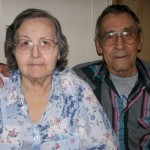 Maeve Parmely. In addition, they now have great great grandchildren, Cambree Petersen, Caysen Petersen, Justin Petersen, Axel Petersen, and Cyler Petersen. A number of these, they never had the privilege of meeting, sadly. Nevertheless, little did they know, when they started out, just how far-reaching their love would be. Their family has grown so much, and it’s not done growing yet. Today marks the 75th anniversary of my in-laws, Walt and Joann Schulenberg’s wedding. I wish they could be here to celebrate. Happy anniversary in Heaven, Mom and Dad. We love and miss you very much.
Maeve Parmely. In addition, they now have great great grandchildren, Cambree Petersen, Caysen Petersen, Justin Petersen, Axel Petersen, and Cyler Petersen. A number of these, they never had the privilege of meeting, sadly. Nevertheless, little did they know, when they started out, just how far-reaching their love would be. Their family has grown so much, and it’s not done growing yet. Today marks the 75th anniversary of my in-laws, Walt and Joann Schulenberg’s wedding. I wish they could be here to celebrate. Happy anniversary in Heaven, Mom and Dad. We love and miss you very much.

 Sometimes, what seems like a necessary change, and what might have been done with good intentions, ends up being far more detrimental than helpful. In the United States, from 1879 to 1933 our monetary system was based on and utilized gold. The lone exception to that was the embargo on gold exports during World War I. With the gold standard, creditors had the right to demand payment in gold. It was a stable and tangible source of income and payment, and it ensured that the borrower actually had the funds to make the payment. The bank failures during the Great Depression of the 1930s frightened the public, causing them to begin hoarding gold, making the “payment in gold” policy untenable, furthering the panic. On June 5, 1933, Congress enacted a joint resolution nullifying the right of creditors to demand payment in gold, thereby taking the United States off the gold standard. That meant that our currency was no longer backed by gold. This may not have seemed like a bad solution at the time, but it certainly opened the door for a number of huge problems later.
Sometimes, what seems like a necessary change, and what might have been done with good intentions, ends up being far more detrimental than helpful. In the United States, from 1879 to 1933 our monetary system was based on and utilized gold. The lone exception to that was the embargo on gold exports during World War I. With the gold standard, creditors had the right to demand payment in gold. It was a stable and tangible source of income and payment, and it ensured that the borrower actually had the funds to make the payment. The bank failures during the Great Depression of the 1930s frightened the public, causing them to begin hoarding gold, making the “payment in gold” policy untenable, furthering the panic. On June 5, 1933, Congress enacted a joint resolution nullifying the right of creditors to demand payment in gold, thereby taking the United States off the gold standard. That meant that our currency was no longer backed by gold. This may not have seemed like a bad solution at the time, but it certainly opened the door for a number of huge problems later.
President Roosevelt had seen how this worked when Britain was facing similar pressures, and they decided to drop the gold standard in 1931. So, when the Great Depression hit, Roosevelt decided to implement it in the US. Soon after taking office in March 1933, President Roosevelt declared a nationwide bank moratorium in order to prevent a run on the banks by consumers lacking confidence in the economy. At the same time, he forbade banks from paying out gold or to exporting it. He based his decision on the Keynesian economic theory, which states that one of the best ways to fight off an economic downturn is to inflate the money supply. If the amount of gold held by the Federal Reserve is increased, it would in turn increase its power to inflate the money supply.
With that in mind, Roosevelt, on April 5, 1933, ordered all gold coins and gold certificates in denominations of more than $100 turned in for other money. The order required all persons to deliver all gold coin, gold bullion, and gold certificates owned by them to the Federal Reserve by May 1, 1933. In exchange, they were to be given $20.67 per ounce. I’m sure it seemed like a good deal, so the people complied. By May 10, the government had taken in $300 million of gold coin and $470 million of gold certificates. Congress two months later, enacted a joint resolution repealing the gold clauses in many public and private obligations that required the debtor to repay the creditor in gold dollars of the same weight and fineness as those borrowed. To complete the inflation process, in 1934, the government price of gold was increased to $35 per ounce, effectively increasing the gold on the Federal Reserve’s balance sheets by 69 percent. This increase in assets allowed the Federal Reserve to further inflate the money supply. So, with a stroke of the pen, the Federal Reserve, and thereby the government increased their wealth by 69%…overnight.
The $35 per ounce value of gold held August 15, 1971, when President Richard Nixon announced that the United States would no longer convert dollars to gold at a fixed value, thus completely abandoning the gold standard. Now I’m not an economist, but if I understand this correctly, it was at that point that the United States, as well as many other nations, began using what is known as “Fiat Money.” Fiat money is “a type of currency that is not backed by a precious metal, such as gold or silver. Fiat money is an intrinsically valueless object or record that is accepted widely as a means of payment. Accordingly, the value of fiat money is greater than the value of its metal or paper content.” It is designated by the issuing government to be legal 
 tender and it was authorized by government regulations, which means that the government could decide what its value would be. That would render the money to be worthless. Not that it changed much in the amounts of Fiat money in use at the time, but in 1974, President Gerald Ford signed legislation that permitted Americans to own gold bullion again.
tender and it was authorized by government regulations, which means that the government could decide what its value would be. That would render the money to be worthless. Not that it changed much in the amounts of Fiat money in use at the time, but in 1974, President Gerald Ford signed legislation that permitted Americans to own gold bullion again.
 When people started moving west in the United States, the trips took approximately four months by wagon train. At that time, saying “goodbye” to loved ones was a very sad moment, because many times people would never see each other again. The distance was just too great and the cost too much, and unless people were moving permanently, they simply couldn’t take the trip. At that time…the 1860s, they likely had no idea that things would get easier either.
When people started moving west in the United States, the trips took approximately four months by wagon train. At that time, saying “goodbye” to loved ones was a very sad moment, because many times people would never see each other again. The distance was just too great and the cost too much, and unless people were moving permanently, they simply couldn’t take the trip. At that time…the 1860s, they likely had no idea that things would get easier either.
Nevertheless, just a short sixteen years later, all that changed. The train wasn’t a completely new invention in the 1860s, and in fact was invented in 1829. Still, as the United States was experiencing its expansion to the west, there were few towns and no railroads. So, moving west still meant that families might never see their departing loved ones again, and if the did, it would be a number of years. During the early 19th century, when Thomas Jefferson first dreamed of an American nation stretching from “sea to shining sea,” it took the president 10 days to travel the 225 miles from Monticello to Philadelphia via carriage. The distance from New York to San Francisco (which was founded in 1776, but didn’t become part of the United States until the signing of the Treaty of Guadalupe Hidalgo in 1848). Jefferson was president from 1801 to 1809. The distance from New York City to San Francisco is 2,565 miles from New York City, making the carriage time in those days approximately 114 days, or a little less than a third of a year. If you weren’t moving west, you would also have to make the return trip. It just wasn’t feasible.
Jefferson saw a possible answer to his dilemma as early as 1802, with “the introduction of so powerful an agent as steam.” At that time, he predicted, the possibility of “a carriage on wheels” that would make “a great change in the situation of man.” For Jefferson, the change would not come soon enough, and he never witnessed the 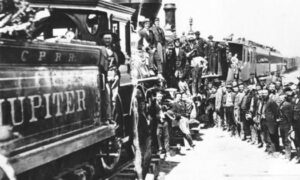 “carriage on wheels” he had envisioned. Nevertheless, within half a century, America would have more railroads than any other nation in the world, and by 1869, America would see the first transcontinental line linking the coasts was completed. Now, those journeys that were impossible for any reason but moving, that had previously taken months using horses, could be made in less than a week. In fact, on June 4, 1876, the Transcontinental Express train traveled from New York City to San Francisco in a mere 83 hours.
“carriage on wheels” he had envisioned. Nevertheless, within half a century, America would have more railroads than any other nation in the world, and by 1869, America would see the first transcontinental line linking the coasts was completed. Now, those journeys that were impossible for any reason but moving, that had previously taken months using horses, could be made in less than a week. In fact, on June 4, 1876, the Transcontinental Express train traveled from New York City to San Francisco in a mere 83 hours.
It seemed inconceivable that a human being could travel across the entire nation in less than four days. Nevertheless, now the impossible had become not only possible, but a reality, and the United States became a very mobile nation. Prior to that time, the coast were months apart, and it was speculated that the nation couldn’t possibly stay united. They couldn’t even communicate very well, much less see each other. Now, those problems were in the past. Just five days later, daily passenger service began. You simply can’t hold progress back. Once the technology is available, the reality isn’t far behind. Americans were amazed at the speed and comfort of this new form of travel. Of course, it wasn’t for everyone, because as with all new inventions, it was expensive and therefore, only for the wealthy. The train was luxurious, with first-class passengers riding in beautifully appointed cars with plush velvet seats that converted into snug sleeping berths. The finer amenities included steam heat, fresh linen daily and gracious porters who catered to their every whim. For an extra $4 a day, the wealthy traveler could opt to take the weekly Pacific Hotel Express, which offered first-class dining on board. As one happy passenger wrote, “The rarest and richest of all my journeying through life is this three-thousand miles by rail.”
A third-class ticket could be purchased for only $40–less than half the price of the first-class fare. At this low rate, the traveler received no luxuries. Their cars, fitted with rows of narrow wooden benches, were congested,  noisy and uncomfortable. The railroad often attached the coach cars to freight cars that were constantly shunted aside to make way for the express trains. Consequently, the third-class traveler’s journey west might take 10 or more days. Still, no one complained, because 10 days was far better than four months, and sitting on a hard bench seat was still much better than six months walking alongside a Conestoga wagon on the Oregon Trail. Of course, this amazing method of transportation would only be amazing for a short time in history, as trains gave way to cars and eventually airplanes. Still those things were either a way off, or would have to wait for the necessary roads and airports to make those forms of travel available. Trains were here now, and life was good!!
noisy and uncomfortable. The railroad often attached the coach cars to freight cars that were constantly shunted aside to make way for the express trains. Consequently, the third-class traveler’s journey west might take 10 or more days. Still, no one complained, because 10 days was far better than four months, and sitting on a hard bench seat was still much better than six months walking alongside a Conestoga wagon on the Oregon Trail. Of course, this amazing method of transportation would only be amazing for a short time in history, as trains gave way to cars and eventually airplanes. Still those things were either a way off, or would have to wait for the necessary roads and airports to make those forms of travel available. Trains were here now, and life was good!!

